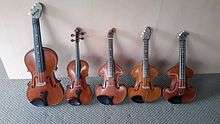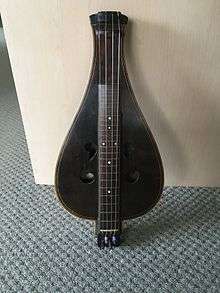Tenor violin


A tenor violin (or tenor viola) is an instrument with a range between those of the cello and the viola. An earlier development of the evolution of the violin family of instruments, the instrument is not standard in the modern symphony orchestra. Its tuning, typically G2 D3 A3 E4 - an octave below the traditional violin, places the range between the cello and viola and thus is sometimes confused with the modern baritone violin which has the same tuning on the standard violin body. As a formal development, the 17th century tenor violin existed as an instrument with a body larger than a viola but with a short neck. In earlier designs, the tenor was played upright in the musician's lap. Tenor violin parts were written in tenor clef (4th line C-clef).
Improvements in string technology in the 18th century led to greater focus of sound coming from the viola and cello ranges leading to a diminished role for tenor violins and violin makers constructed fewer of these instruments. It is known that Antonio Stradivari constructed two different models of tenor violin as well as tenor variations of violas.
In the modern new violin family or violin octet, the tenor violin exists as an instrument tuned an octave below the violin and approximately the same size as a 3/4 cello. The baritone violin in the same is an enlarged version of the cello.
Tenor Violins were again becoming somewhat popular in Germany during the late 19th century to the early 20th century featuring four strings tuned to G D A E with the G string tuned to the same octave as the modern Cello. They were meant to be played on the lap same as the soprano/alto sized Viola da Gamba but some were also fitted with chin rests for playing on the shoulder. The fingerboard has a similar fretted fingerboard as the Viola da Gamba, and the body is eighteen inches long and 30 inches long overall and the ribs being 1/8th of an inch higher than today's standard 16 inch viola. They are much more difficult to play as the finger falls on the E string directly on top of the raised fret and then ever so little behind the fret more and more progressively so that the first finger falls for the A on the G string more closer to the fret behind. The frets are conveniently removable and easily refitted on some of the late 19th century tenor violins. On others, the frets are permanent. The frets are usually made of white copper which is an alloy of tin and copper. Sometimes white copper frets are inlaid into the top of the bridge and also can be used for the nut. If so, a thin strip of vellum is used in between the white copper fret and the string, this protects the string from wear and also greatly improves the tone. The smaller size tenor violins from this same period are comparable in size to a modern day 15 inch viola but with much variation in shape to create the extra volume to make suitable the instrument to suit the tenor octave as well as the fingerboard being an inch longer than the standard modern 15 inch viola and the tail piece being shortened by about 2 inches, thereby increasing the vibrating string length by three and a half inches, resulting in changing the tension within the body of the tenor violin and strings, thus dropping the tuning of the violin to GDAE in the cello octave and creating an incredibly marvellous mellow sound. The variations in size of body correspond in golden ratio with the changes to the fingerboard and tail piece length. Another variation seen on 19th Century Tenor violins is that sometimes the maker will keep the fingerboard length as per a normal violin and dispense with the tail piece altogether, having the strings loop onto studs fixed directly onto the ribs in the area of the main block that supports the saddle. This increases the vibrating string length to five inches longer than on the standard violin and neccessitates an increase in size of this tenor violin which is accomplished by the violin sides being flared out far wider than what is standard to create the extra sound box volume necessary to match the extra vibrating string length. On the oversized tenor violins the bow response is slow and heavy compared to the violin and more comparable to Cello. On the smaller sized tenor violins the bow response is similar to the viola. Modern viola strings best suit these violins, fitting violin strings and using longer tail piece does not work so well nor create the best sound and using quarter to half size cello strings does not suit at all.
The large German Tenor Violins of this period create a beautiful and loud resonance with choir or orchestra which greatly amplifies their sound, more so with choir than orchestra. This tenor violin is so sensitive to choir that it will, in combination with choir, produce a resonance sound loud enough that can be easily heard by the player even when nothing is used over the strings. Many of these were configured with bass bar and sound post combinations situated in the reverse of today's modern violins to enable German Table Violin players to play without changing their technique. If the Tenor violin has the reverse configurations, the strings can, amazingly, still be fitted as per a typical modern violin with no alteration to the sound. The bridge is no longer commercially available and is best constructed of a half or quarter sized cello bridge with feet cut short to accommodate the difference. Viola bridges are unsuitable being too thin and low causing wolfy notes, especially on the E string but a violin master can make an oversized viola bridge to suit and this works well. This tenor violin has the body after the Stradavarius pattern, the fingerboard similar to the Viola da Gamba, and the tuners similar to the mandolin or german harp and some of the later having a pegbox and pegs as per the modern violin, and strung with viola strings.

Another interesting variation of the Tenor violin was made by Gustave Bernadel in Paris. He was a maker of quality stringed instruments in the latter half of the 19th Century. His workshop produced a Tenor violin based on his own interpretation of the dulcimer and was meant to be played on the leg and has a vibrating string length about two and a half inches greater than a standard violin. It is strung with viola strings, having a fingerboard with raised or instate frets, plays with lesser volume than the typical modern violin and has a particular sound entirely peculiar in itself, yet beautiful. Gustave Bernadel did not incorporate a tailpiece in his Tenor violin pattern, but looped the strings directly on to studs fastened onto an overly large saddle that also doubles as the front end block. The tuning is done with friction studs in lieu of a peg box and looks somewhat like a dulcimer more than a Tenor violin. The bridge is one piece solid with a white copper fret over the top. A thin vellum strip sits between the white copper fret and the strings to firmly locate the strings onto the bridge and prevent the bridge from flipping over and also to stop the scouring of the strings that would occur in the tuning of the instrument. The vellum strip also, amazingly, causes the dulcimer/tenor violin's sound to increase and improve from coarse to mellow and with an easily discernable increase in volume.
By analogy with the vocal quartet of soprano-alto-tenor-bass, a few composers featured the tenor violin as the voice between the alto of the viola and bass of the cello (e.g. Felix Draeseke or Sergei Taneyev. In contemporary musical improvisation these instruments are again finding a place.
Modern incarnations of the tenor violin are the viola profonda and the violotta (both held at the shoulder).
Classic tenor violins
Modern makers of tenor violins
- Tenor violins played at the shoulder like a violin or viola:
Neuner Hornsteiner (Bayern, 1880)
- J.C. Letellier (France, c. 1925)
- Alfred Stelzner (Germany, c. 1890 - Violotta)
- Harry Vatilliotis (Australia, c. 2000)
- Johann Reiter (Germany, c. 1950)
- Gerardo Yañez (Bolivia, 2007, Viola Profonda)
- Alexandr Shchipanov (Russia, 2014)
- Tenor violins played vertically like a cello:
- Carleen Hutchins (United States, c. 1970-1992, tenor violin, part of the New Violin Family)
- Robert J. Spear (Ithaca, NY USA 2000–present, New Violin Family)
- Joris Wouters (Westerlo, Belgium 2000–present New Violin Family))
See also
Further reading
- Kory, Agnes (1994). "A Wider Role for the Tenor Violin?". The Galpin Society Journal. 47 (Mar., 1994): 123–153. doi:10.2307/842665. JSTOR 842665.
- Segerman, Ephraim (1995). "The Name 'Tenor Violin.". The Galpin Society Journal. 48 (Mar., 1995): 181–187. doi:10.2307/842810. JSTOR 842810.
